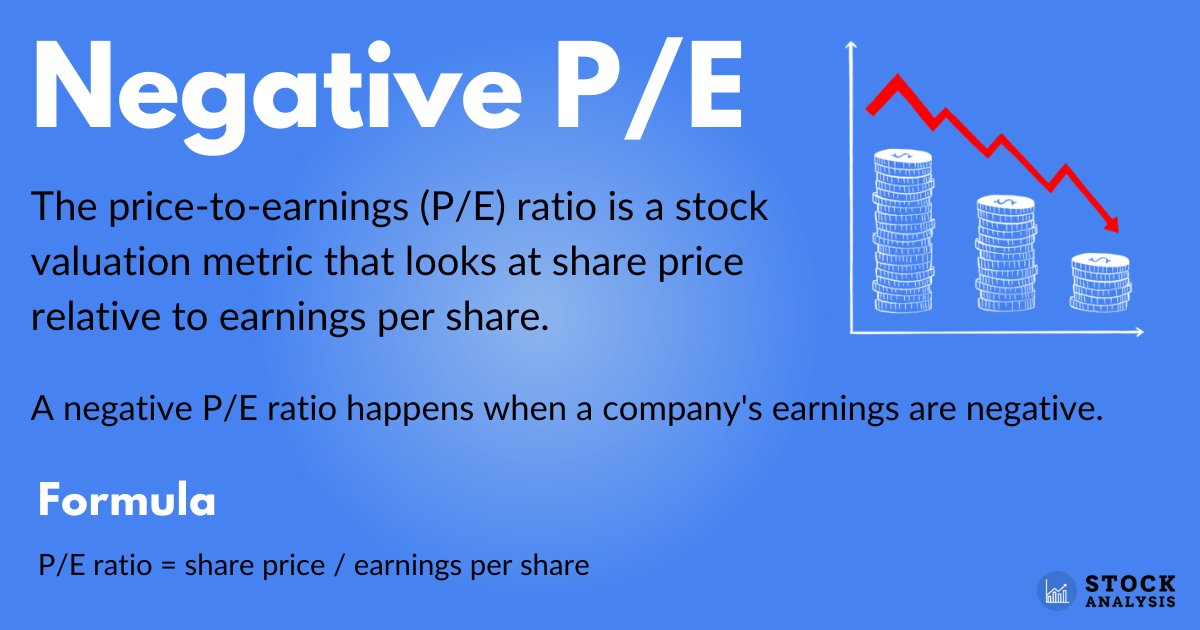Negative P/E Ratio

The price-to-earnings (P/E) ratio is a stock valuation metric that looks at share price relative to earnings per share. A negative P/E ratio means that a stock is losing money.
The formula for the P/E ratio is as follows:
P/E ratio = share price / earnings per share
If the result is negative, oftentimes the P/E ratio will be written as N/A.
Below is an overview of what a negative P/E ratio means, including why it happens and what it means when making investment decisions.
What does a negative P/E ratio mean?

The price-to-earnings (P/E) ratio is the most commonly used ratio to determine the value of a stock relative to its earnings.
In very general terms, a high P/E ratio indicates a stock is expensive, while a low P/E ratio suggests that it is inexpensive. However, it's more nuanced than this.
Oftentimes, a high P/E can indicate a growing company, while a low P/E would indicate a company is not growing as quickly. When using P/E for analysis, it's important to consider growth and cash flow expectations, in addition to price.
A negative P/E ratio means that a stock has negative earnings, or the company was losing money over the past 12 months. Importantly, the P/E ratio will only be negative if the earnings per share (EPS) is negative. The share price itself can never be less than zero.
A negative EPS means the stock had negative net income (net losses) for the last 12 months. In other words, adding up the earnings for the past four fiscal quarters results in a negative number.
This does not mean that all the quarters were negative, just that the total number was lower than zero. For example, if the EPS of the last four quarters was +1, +2, +3, and then -7, the EPS would be -1, causing the P/E ratio to also become negative.
It's also worth noting that EPS is sensitive to accounting methods, so a negative number doesn't always imply that a stock is a bad investment. Overall, it depends on many factors.
SummaryA negative P/E ratio happens when a stock's EPS falls below zero. Often, this can mean a company is losing money. However, it's wise to dig deeper and assess the larger context of the company's financial situation.
Why does a negative P/E ratio occur?
Here are a few reasons why a stock might have a negative EPS and a negative P/E ratio:
- Struggling business: The company might truly be struggling, consistently spending more cash than it takes in just to stay afloat. This company has a high chance of bankruptcy and is likely a bad investment.
- Unprofitable growth stock: Many companies with strong revenue growth (like some tech stocks) are unprofitable. But people invest in them because they are growing fast and may become profitable in the future.
- Biotech stocks: It is very common for biotech stocks to have little to no revenue and high expenses. But they may be working on a new drug that will become immensely valuable in the near future.
- Change in accounting: Changes in accounting methods can sometimes cause EPS to go negative for a short period, even if the company didn't lose any money.
- One-off expenses: A company may occasionally need to pay a big one-time expense, like a major fine. Or, it could need to write down some major asset. That can cause EPS and P/E to go negative temporarily.
SummaryA company can have a negative EPS for several reasons, such as a failing business, being a startup, the nature of the business, a change in accounting, or one-off expenses.
Should you buy a stock if it has a negative P/E ratio?
To decide whether or not to buy a stock with a negative P/E ratio, you should first do some research.
To start, see if the company has had losses for a long time or if the losses only occurred recently. Consistent losses can mean the company is in trouble, but more recent losses could be caused by accounting effects or one-time expenses.
It's also helpful to look at the earnings of other companies in the same industry. If most of the companies have losses, then perhaps the entire industry is in a temporary cyclical downturn.
A good way to see whether negative earnings and negative P/E are caused by accounting is to look at the cash flow statement. This can tell you if the company is actually spending more cash than it takes in or if the negative earnings were due to some accounting rules.
Looking at a company's revenue growth rate and margin trends is also a good idea. Some high-growth companies are investing all their earnings in growing the business but still have a clear "path to profitability" if their plans work out.
However, it can be risky to invest in unprofitable growth companies and biotech stocks. Don't buy stocks in such companies unless you know what you're doing.
Additionally, when P/E is negative, other metrics such as P/FCF, P/S, or P/EBITDA may be used.
SummaryA negative P/E ratio does not necessarily mean that a stock is a bad investment. The P/E ratio is just one number out of many, and you need to consider it in context with other metrics and the future prospects of the business.
Negative P/E is generally listed as N/A
A negative P/E ratio can be confusing because a very negative number is actually better than a number that's just slightly negative.
For example, imagine two hypothetical stocks that each cost $100 per share.
Company A has an EPS of -$100, which implies massive losses. But company B has an EPS of -$0.01, so it's on the verge of being profitable.
In these cases, company A has a negative P/E ratio: $100/-$100 = -1. But company B, which is on the verge of profitability, has a very high negative P/E ratio: $100/-$0.01 = -10,000.
In this case, the bigger negative number is actually the better one. It means that the company's losses are minimal.
This is the opposite of a positive P/E ratio, where a smaller number is generally seen as a good thing, while a bigger number implies that the stock is more expensive.
Because this is confusing and not very informative, most financial information websites, including Stock Analysis, don't show the P/E ratio if it's negative. Instead, they show N/A, meaning not applicable, or a dash where the P/E ratio is supposed to be.
Finance and stock information websites will show you if a stock is unprofitable in other ways, such as by showing a negative net income or EPS number.
SummaryWhen the P/E ratio is negative, it's generally listed as N/A. This is because a very highly negative number is better than a slightly negative number, which is the opposite of how a positive P/E ratio is interpreted, and can be a confusing and not very helpful number.
The takeaway
The P/E ratio is a valuation metric that shows share price relative to earnings per share (EPS).
A negative P/E ratio occurs when a company's EPS is also negative, meaning the stock had a net loss for the past 12 months.
Because a negative P/E can be a confusing number, it's generally listed as N/A.
A negative P/E ratio is not a good sign but it also doesn't tell the whole story. In some cases, such as that of a startup business, negative earnings may not be cause for concern.
However, you should definitely investigate further before making any investment decisions, digging into the company's cash flow statement, assessing earnings trends over time, considering the company's future prospects, and analyzing additional metrics.






